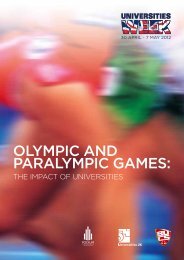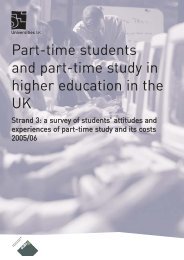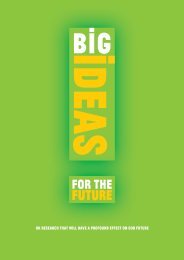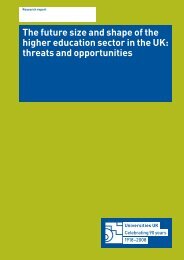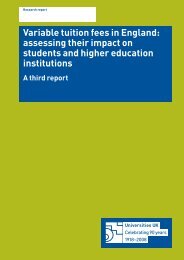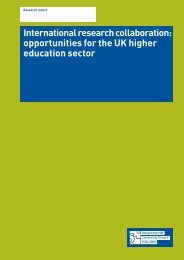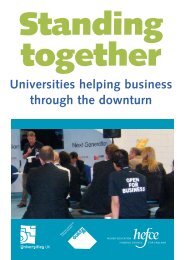Creating Prosperity: the role of higher education in ... - Universities UK
Creating Prosperity: the role of higher education in ... - Universities UK
Creating Prosperity: the role of higher education in ... - Universities UK
Create successful ePaper yourself
Turn your PDF publications into a flip-book with our unique Google optimized e-Paper software.
<strong>Creat<strong>in</strong>g</strong> <strong>Prosperity</strong>: <strong>the</strong> <strong>role</strong> <strong>of</strong> <strong>higher</strong> <strong>education</strong><strong>in</strong> driv<strong>in</strong>g <strong>the</strong> <strong>UK</strong>’s creative economy4514. CASE STUDYThe Creative Employability Studio,University <strong>of</strong> WolverhamptonThe school <strong>of</strong> art and design at <strong>the</strong> University<strong>of</strong> Wolverhampton established <strong>the</strong> CreativeEmployability Studio <strong>in</strong> May 2008. TheStudio, which is wholly funded by <strong>the</strong> school,promotes and enhances student employabilitythrough real-work <strong>in</strong>itiatives and <strong>the</strong>development <strong>of</strong> commercial awarenessskills. It creates a central po<strong>in</strong>t for all creativeemployability activity undertaken by <strong>the</strong>University, which was previously limited,fragmented and ad hoc.The Studio model comprises four coreelements that overlap:• Work: this provides real-work opportunities(placements and live briefs) that allowcreative students to use <strong>the</strong>ir skills <strong>in</strong>a commercial context. In recognition <strong>of</strong><strong>the</strong> difficulties for creative bus<strong>in</strong>esses <strong>in</strong>provid<strong>in</strong>g long-term placements, shorttermplacements are <strong>of</strong>fered. The Studioalso advertises employment opportunitiesand assists <strong>the</strong> sector with recruitment.• Skills: this develops <strong>the</strong> employabilityskills <strong>of</strong> <strong>the</strong> students by seek<strong>in</strong>g outexhibition space for <strong>the</strong>ir own work,advertis<strong>in</strong>g and encourag<strong>in</strong>g students toenter competitions, <strong>in</strong>vestigat<strong>in</strong>g how andwhere students can promote and sell <strong>the</strong>irwork, and assist<strong>in</strong>g students to developcommercial skills through network<strong>in</strong>gand self-promotion activities.• Industry: this <strong>in</strong>volves <strong>the</strong> provision<strong>of</strong> workspace to current practitionersand micro-bus<strong>in</strong>esses, and <strong>in</strong>dustrycommunication, events and sponsorship.Crucially, <strong>the</strong> Studio provides a focalpo<strong>in</strong>t for <strong>in</strong>dustry and gives <strong>in</strong>dustry<strong>the</strong> means to talk to <strong>the</strong> University.• Practitioners: this seeks to engagethose currently work<strong>in</strong>g <strong>in</strong> <strong>the</strong> sector,and comprises practitioners-<strong>in</strong>-residenceschemes, ‘honorary practitioners’provid<strong>in</strong>g workshops and sem<strong>in</strong>ars, and<strong>the</strong> creation <strong>of</strong> ‘success stories’ to providelocal examples <strong>of</strong> what previous studentshave achieved.The holistic approach <strong>of</strong> comb<strong>in</strong><strong>in</strong>g acollection <strong>of</strong> activities under <strong>the</strong> one projectis <strong>of</strong> value and recognises that employabilityskills cannot simply be learned, but <strong>the</strong>y mustbe acquired over time and ref<strong>in</strong>ed througha variety <strong>of</strong> methods.The background <strong>of</strong> <strong>the</strong> staff, with manyhav<strong>in</strong>g been practitioners, helps achieve<strong>in</strong>dustry and academic buy-<strong>in</strong>. With many<strong>in</strong>dustry practitioners sceptical with regardsto what academics know about <strong>the</strong> realities<strong>of</strong> <strong>in</strong>dustry, persistence <strong>in</strong> relationshipbuild<strong>in</strong>g is required.At a more practical level, hav<strong>in</strong>g one ma<strong>in</strong>physical space where all employability activityis centred provides a focal po<strong>in</strong>t for all keystakeholders: <strong>in</strong>dustry, students/graduatesand academia.4.105 A similar set <strong>of</strong> issues arises <strong>in</strong> <strong>the</strong> context <strong>of</strong> entrepreneurship <strong>education</strong>, a dist<strong>in</strong>ct but relatedcomponent <strong>of</strong> <strong>the</strong> wider employability agenda. Research has identified a lack <strong>of</strong> entrepreneurship asa barrier to <strong>the</strong> effective growth <strong>of</strong> <strong>the</strong> <strong>UK</strong>’s creative <strong>in</strong>dustries (NESTA 2006), and yet <strong>the</strong> freelanceculture demands a degree <strong>of</strong> entrepreneurial skill. Evidence regard<strong>in</strong>g <strong>the</strong> extent <strong>of</strong> entrepreneurship<strong>education</strong> <strong>in</strong> <strong>higher</strong> <strong>education</strong> courses related to <strong>the</strong> creative <strong>in</strong>dustries is somewhat conflict<strong>in</strong>g.4.106 In <strong>the</strong>ir review <strong>of</strong> entrepreneurship <strong>education</strong> for <strong>the</strong> creative <strong>in</strong>dustries, NESTA and <strong>the</strong> HE Academy(2007) found ‘significant enthusiasm for entrepreneurship <strong>education</strong>’ with<strong>in</strong> art, design and mediasubjects as well as a wide range <strong>of</strong> different approaches. Eighty per cent <strong>of</strong> <strong>the</strong> respondents <strong>in</strong> <strong>the</strong>irsurvey reported some form <strong>of</strong> entrepreneurship teach<strong>in</strong>g <strong>in</strong> <strong>the</strong>ir <strong>in</strong>stitution. However, <strong>the</strong> NationalCouncil for Graduate Entrepreneurship (NCGE, 2007) found that entrepreneurship <strong>education</strong> is stilldom<strong>in</strong>ated by bus<strong>in</strong>ess and management schools (61 per cent <strong>of</strong> all provision), with less provision<strong>in</strong> creative arts and design courses (eight per cent). Although based on different analyses, thisdoes suggest a degree <strong>of</strong> mismatch.4.0 Higher <strong>education</strong>’s contribution



